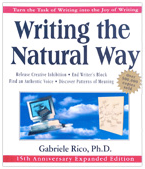Clustering: A Prewriting Technique That Overcomes Writers’ Block
L.C. Scott is the founder of eFrog Press and an author. Her many years of teaching at the high school and university level and her freelance writing career have prepared her to lead a team of experts to guide both fledgling and experienced authors through the maze of indie publishing. Today on Take the Leap she shares a powerful technique for dispelling writers’ block and unlocking your creativity.
Clustering is a magical tool for writers of any age and genre. It’s a technique that frees the creative side of your brain to leap into action unhindered by rules of grammar and structure. Your creativity flows uninhibited and you can solve writing dilemmas that may have blocked you for days, months, or even years.
Clustering Based on Brain Research
Gabriele Rico discovered and named the concept of clustering when doing her doctoral research at Stanford University in the 1970s. Fascinated by reading the latest studies on brain research, she saw ways these new discoveries about how our brains work could be applied to writing. She had been teaching composition courses at San Jose State University and knew her students would benefit from this new knowledge. .
 In 1983 she published Writing the Natural Way: Using Right-Brain Techniques to Release Your Expressive Powers. I was fortunate to hear her speak about clustering at a San Diego Area Writing Project workshop at the University of California San Diego shortly after its publication and have been applying her techniques ever since—as a writer, writing teacher, doctoral student, and editor.
In 1983 she published Writing the Natural Way: Using Right-Brain Techniques to Release Your Expressive Powers. I was fortunate to hear her speak about clustering at a San Diego Area Writing Project workshop at the University of California San Diego shortly after its publication and have been applying her techniques ever since—as a writer, writing teacher, doctoral student, and editor.
Clustering works as well with second graders as it does with novelists. During the workshop Dr. Rico shared that she struggled to organize the ideas for Writing the Natural Way until she realized she needed to practice what she preached. After months of trying to outline her book, she grabbed some large sheets of paper, got down on the floor with markers, and clustered her topics in just a few hours.
As Dr. Rico wrote:
Clustering is a nonlinear brainstorming process akin to free association. It makes a Design-mind process visible through a nonlinear spilling out of lightning associations that allows patterns to emerge. Through clustering we naturally come up with a multitude of choices from a part of our mind where the experiences of a lifetime mill and mingle. It is the writing tool that accepts wondering, not-knowing, seeming chaos, gradually mapping an interior landscape as ideas begin to emerge. [Writing the Natural Way, p. 28]
Clustering in Action
A student in my doctoral cohort a few years ago was almost hyperventilating as she discussed writing her dissertation. The more she talked about it, the more agitated she became. I knew she had a great topic and had done her research. All she needed to do was relax and write, but in her present state that was not going to happen. The dreaded ABD (All But Dissertation) loomed in her future if she did not conquer her nerves.
So I showed her how to cluster, gave her a blank piece of paper, and encouraged her to just try it. Once she had filled the page with circles and connecting arrows, I suggested she write a quick rough draft and that she write badly. Badly? She nearly shouted, “This is my dissertation!”
I replied, “I know. But trust me. I teach writing. Just get it down on paper first. Later you can revise until it is amazing. First, just write. Do not check spelling, punctuation, or word choice. No thesaurus, no dictionary. Just write and get it all out. Then you can clean it up.”
Although she was skeptical, she was also desperate. A dissertation was born and a doctoral degree was conferred.
How to Cluster
So when you are beginning a writing project, consider clustering. It is the most powerful form of prewriting I know.
1. Write a single word or phrase in the center of a blank sheet of paper and circle it. Dr. Rico calls this word or phrase the nucleus.
2. Let your thoughts flow and jot down every word that comes to mind around the first word.
3. Circle the new words and draw lines to connect. Focus on the new words and cluster around them too.
4. Continue to expand this web of words until you have run out of thoughts.
Why circles? Dr. Rico explains: “By its very nature the circle centers, focuses. . . . The circle implicitly suggests bringing into being, activating, animating the pattern-making forces of the creative process” [p. 42]. See sample clusters and the resulting vignettes.
I was saddened to learn recently that Dr. Rico died in March 2013. I have benefited greatly from her research and encourage other writers to discover the powerful technique of clustering. Tap into the creative side of your brain and dramatically improve your writing.
Please Share
What techniques have you used to overcome writers’ block?
Tags: brainstorming, clustering, Gabriele Rico, mindmapping, writers' block